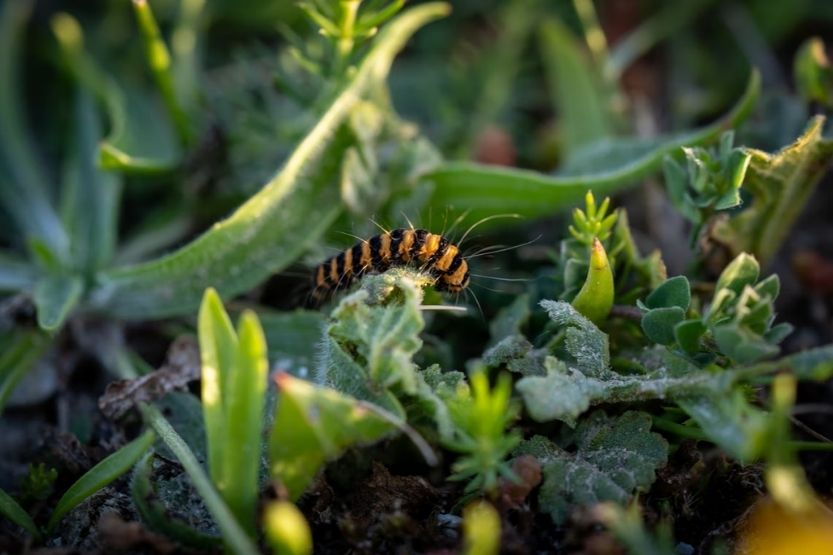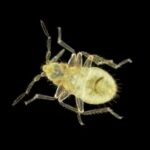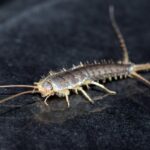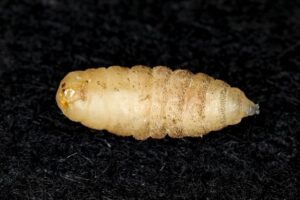While lettuce is fairly easy to grow, they are also easily very susceptible to all kinds of bugs that affect their health. In this article, I will dwell on lettuce bugs – what are they? Are they harmful? How to remove it?
Lettuce bugs are a-plenty. The most common ones are aphids. Some are white but come in many hues, from pink to orange to green. Beetles, crickets, caterpillars, fungus gnats, and other bugs make life harder for lettuce.
Generally, lettuce bugs are not harmful to us. You can even eat lettuce that was attacked by these bugs, as long as you remove the affected portions. To remove bugs from the lettuce, put the plant in a bowl and completely submerge it in water. Add a little vinegar and let it soak for 10 to 15 minutes. The bugs, even if alive, will leave the lettuce alone or die.
Read on to learn more about lettuce bugs, whether they are harmful or not, and how you can remove them from the plant.
Lettuce Bugs – What Are They?

Aphids Are the Most Common Bugs on Lettuce
Lettuce bugs are little creatures that love to eat the leaves of lettuce and other plants. The most common of them are the aphids.
Lettuce aphids have white body colors, although some come in different hues ranging from green to pink to orange. Some of them have wings, while some are wingless.
Other Bugs That Love to Eat Lettuce Plants
Aside from aphids, other bugs also love to eat lettuce plants. They include crickets, beetles, fungus gnats, caterpillars, and many more. Generally, these romaine lettuce bugs are harmless to humans.
Submerge the Lettuce in a Vinegar and Water Solution
But of course, you don’t want to eat lettuce you bought from the grocery with bugs. To remove these bugs, put the lettuce plant in a water bowl with a small amount of vinegar. Allow it to submerge in this solution for about 10 to 15 minutes. The bugs will either leave the plant or die.
Bugs Are Considered Pests
While these bugs are not directly harmless to humans, they can damage crops. That means farmers who grow lettuce consider them pests because they can reduce their harvest and income.
Safe to Eat Lettuce Attacked by Bugs
You may be wondering if you can safely eat lettuce that was attacked by bugs. You can, just as long as you cut out the portions they attacked. Washing the lettuce or rinsing it with water before eating makes it safer to eat even if it was bug-attacked.
Tiny White Bugs In Kitchen – What Are They and How to Get Rid of Them
What Is Eating Holes in Your Lettuce?
We love to eat lettuce but also do bugs. They are very crunchy to eat, and they are very easy to grow. Unfortunately, as they grow, some creatures would like to eat them before we can. What are these bugs that would like to deprive us of our crispy lettuces?
1. Beetles

Not just one, but several types of beetles like to devour lettuce. The most common beetles that love eating lettuce are flea and darkling beetles. These beetles usually come from the soil and also dwell there. They live on plants, and lettuce is one of their favorites.
Flea beetles can jump long distances, which is the most dangerous to lettuce farmers. If you see holes in your lettuce, those are the evidence of their attack. They prefer young leaves, especially the newly sprouted ones. As such, they can affect plant health and impact your harvest.
2. Aphids
Come in Armies
Aphids are the most atrocious bugs that can attack lettuce. They come in armies and invade plant growth incessantly. There are four ways by which these pesky aphids damage plant crops:
- Extract water and nutrients from the plant. This results in the curling of the leaves of the plant, causing its early demise.
- They also eat the leaves.
- Act as vectors of other plant diseases. In the case of lettuces, they encourage plant diseases such as lettuce mosaic.
- Deposit honeydew on lettuce leaves which results in the growth of mold.
Prefer to Eat Young Plants
Aphids prefer to eat young plants, which can also impact your harvest. They can breed rapidly, and even if you have eradicated an entire colony, they can return with a vengeance once they have laid their eggs.
You may already know that aphids have a symbiotic relationship with ants. Ants eat the sweet secretions of aphids, and they protect aphids in return, even helping them move from plant to plant.
3. Caterpillars

Caterpillars also love to eat lettuce plants. If they look like Swiss cheese, you will know if they have attacked your lettuce crop. Unfortunately, there’s not just one type of caterpillar that love to attack lettuce. There are lots of them that relish this plant food.
Cabbage Worms
There are the cabbage worm, cutworms, and cabbage loopers. Cabbage worms are velvety green in color. You won’t be able to see them easily because they usually lay flat inside the spines of the lettuce leaves. These worms come from the eggs laid by the cabbage white butterfly.
Cutworms
Cutworms come from the hatched eggs of different species of the Noctuidae moth family. They love to chew the stems of lettuce and other plants, even cutting the plants down to the level of the soil. These worms are nocturnal creatures and eat plants at nighttime.
They also prefer young plants. If they are not controlled, they will eat an entire crop. You need to control these moths because they breed many times a year. This means you must be watchful of their presence if you have crops of lettuce in your yard.
These types of worms can grow up to two inches long. They can be black in color or gray with stripes or dark green with orange stripes. These worms also love to chew on young seedlings. As such, they can damage your whole crop if unchecked.
Cabbage Loopers
Cabbage loopers, while looking like cabbage worms, are of a different caterpillar specie. Cabbage loopers do not have center legs. They also walk by arching their bodies to bring their rears forward.
Unlike cabbage worms, whose bodies are fuzzy, the bodies of cabbage loopers are soft. They are hatchlings from the eggs of the cabbage looper moth.
4. Fungus Gnats
The fungus gnat is a species from a class of flying insect families. They like to inhabit damp soil where they lay eggs and hatch. The hatchlings of larvae are the ones that infest the roots of seedlings. A green lettuce bug can consume plant roots until it encloses itself in its cocoon.
They will buzz above and around plants when they emerge from their cocoon. They can also rapidly walk across the leaves or the soil. The sad thing about them is that they already have infiltrated your entire lettuce crop when you notice them in your yard.
5. Crickets

The nymphs devour the young seedlings of lettuce plants. The female cricket lays eggs inside a long tube called an ovipositor. Then, buries it into the ground.
When the eggs hatch, the nymphs will look for food. And what can they eat? The softest thing they can find are sprouts of lettuce plants. These sprouts pop out from the ground when these hatchlings come up from their nest holes inside the earth.
6. Leaf Miners
Leaf miners lay their eggs by inserting them into the upper part of the leaf surface. The eggs then transform into larvae which will begin to eat the leaves where they have hatched.
7. Slugs and Snails

Slimy creatures such as snugs and snails also attack lettuce plants. These slithering beings eat different kinds of plants, including lettuce. If there are chewed leaf edges, holes on the leaves, and shiny goop trails, your crop is infested with slugs and snails.
These slithery creatures love damp places, which your soil most probably is, and move in dark places. They also prefer to eat young seedlings and young lettuce leaves. They hide during the day and do their nasty work at night.
Tiny Bugs On Window Sill – What Are They?
Are Lettuce Bugs Harmful?

Perhaps you are worried that you will get sick by eating lettuce leaves infested with bugs. Can these bugs harm us? No, they are not harmful to humans, at least directly.
But since they can damage entire crops, they harm the pockets of lettuce farmers. This will also lead to a shortage in the supply of lettuce in the market.
When that happens, you won’t be able to buy lettuce anymore. In that sense, these bugs can harm us – but not directly.
But you may wonder: can we eat lettuce attacked by bugs and nothing bad will happen? Lettuce with holes is fine to eat if you remove the affected parts.
However, if you find poops of wild animals, such as rodents, rabbits, or deer, on the leaves of your lettuce, don’t eat them. They may carry pathogens that can endanger your health.
It is always best to check the condition of your greens before eating them. The lettuce should be relatively safe if there are only holes and no poop.
At any rate, you are not to eat any greens without washing them in clean water. So, ensure there are no mammal poops but only holes in your lettuce. They should be fine to eat.
Again, are lettuce bugs harmful? Aphids on lettuce will not harm the lettuce. But, consumers do not buy lettuce with bugs on them.
Small White Worms in House – What Are They and How to Get Rid of Them
How to Control Bugs in Lettuce
You can’t stop these bugs from breeding during their seasons, but you can control their spread in your lettuce crops so they won’t severely affect your harvest. Here are some ways you can control these bugs:
1. Introduce Natural Repellants
Now that you know that bugs love to eat young lettuce plants, it is best to take steps to prevent these bugs from infesting your lettuce crop even before they attack. You can introduce natural repellants that will discourage these bugs from attacking.
Nematodes
You can introduce nematodes to your soil. They will benefit your lettuce seedlings because they will feed on the eggs and larvae of these bugs. So, they won’t be able to hatch and emerge as worms, caterpillars, or bugs.
There are specialty stores that sell nematodes, such as NemaSee HB. You can get the nematodes in packages containing 5 million to 500 million. Just follow the package instructions on how to apply them to your soil.
Natural Predators
You can also introduce natural predators of lettuce bugs that will prevent them from breeding and hatching. The natural predators of aphids and these other bugs include:
- Birds,
- Lacewings,
- Ladybugs,
- Flower fly maggots,
- Damsel bugs, and
- Parasitic wasps.
They will not touch your lettuce but pick up the worms and bugs on their leaves, sprouts, and seedlings.
Neem Oil
You can also use neem oil to deter these bugs from eating your young lettuces. Spray it all over your plants, and it will repel the bugs that would otherwise munch on their leaves.
Neem oil will also smother these bugs and make them weak. Just be sure to use neem oil on plants according to the instructions on the package.
2. Use Pesticides or Other Natural Methods to Get Rid of Caterpillars
If the caterpillar infestation is already severe, you can use pesticides to kill them. However, there could be adverse repercussions on the soil and your health if you use this remedy. So, use it only when the situation is no longer manageable.
It is best to use natural methods of eradicating caterpillars, such as introducing nematodes, birds, and other natural bug predators to the affected plants. They will do the work by eating the caterpillars and their larvae.
3. Remove Crickets’ Hiding Spots
You can control the number of crickets in your lettuce crop by removing their hiding spots. So, remove rotting fruit and vegetables in your garden and other decaying organic materials near your lettuce crop.
If the infestation is already severe, you can use diatomaceous earth to reduce the number of crickets in your garden. Sprinkle the DE throughout your garden.
When bugs come in contact with the DE powder, their bodily juices will dry up and die. Be careful in using DE because it can also kill beneficial organisms in your yard.
4. Eliminate Fungus Gnats by Letting the Infested Soil Dry Out
One way to control fungus gnats is to let the infested soil dry out completely. When the soil has fully dried out, break it up and expose as much of it to the air. So, do this before planting your lettuce crop.
You can also use ground cinnamon to eradicate fungus gnats. Cinnamon is toxic to the larvae of these gnats, so they won’t be able to develop as gnats. This powder can also prevent adult female fungus gnats from laying their eggs.
5. Use Salt to Control Snugs and Snails
You can control the number of snugs and snails in your soil by removing their hiding places and clearing out the debris in your yard. Salt is also toxic to these slithery creatures.
So, spread a generous amount of salt around the plant edges. This will prevent them from slithering their way into your lettuce plants.
Frequently Asked Questions – Lettuce Bugs – What Are They?

If you still have questions you want to be answered, just read the answers to the most often asked question about this topic. You may find your answers here:
What Are These Bugs That Crawl in Lettuce Leaves?
There are different kinds of bugs that crawl and eat lettuce leaves. The most common of them are the aphids. Other bugs that love to eat lettuce leaves include:
- Crickets,
- Beetles,
- Fungus gnats,
- Caterpillars,
- Leaf miners, and
- Snugs and snails.
How Can I Remove Bugs from a Lettuce Leaf?
You can remove bugs from your lettuce leaf by soaking it in a water bowl. Once the lettuce is submerged in water, add some amount of vinegar. Wait for about 10 to 15 minutes, and you will see the bugs crawling out of the leaves. Remove the lettuce leaf from the water; it should be bug-free.
Are Lettuce Bugs Harmful to Us?
No, they are not harmful to humans directly. Eating lettuce leaves attacked by these bugs won’t harm you, as long as you don’t eat the affected parts of the leaves.
However, these bugs can affect the harvest of lettuce farmers by eating part if not most of their crops. So, you can say that they can affect the livelihood of lettuce farmers.
Are There Ways to Prevent These Bugs from Eating Lettuce Crops?
Yes, many effective ways to prevent bugs from eating lettuce. It is best to make use of natural methods. But if the bug infestation is already severe, you can use pesticides to eradicate these pests.
However, the best way is to use natural methods to eliminate bugs. One way is to introduce natural predators to the farm or yard where lettuce is grown. Another way is to use diatomaceous earth. Spreading DE on the soil will control the growth of these bugs.
In Closing: What Are Lettuce Bugs – Are They Harmful?
There are plenty of bugs that can attack lettuce. The most common are aphids. Some aphids have white bodies, but others have different color hues ranging from green to pink to orange.
Other bugs that attack lettuce include fungus gnats, caterpillars, crickets, beetles, and many more.
Generally, lettuce bugs are not harmful to humans. You can even eat the lettuce they have attacked, as long as you remove the portions they have eaten. They are relatively harmless because they don’t bite, and they don’t cause diseases.
Read next:


![Tiny Bugs in Bed [Not Bed Bugs] - What Are They? Tiny Bugs in Bed](https://homecarezen.com/wp-content/uploads/2022/01/tiny-bugs-in-bed-150x150.jpg)






